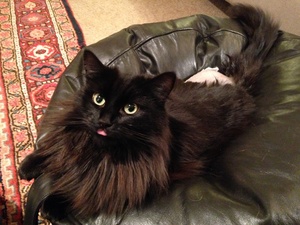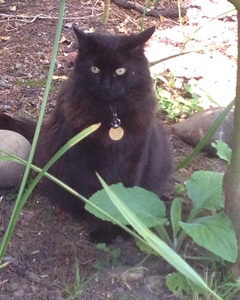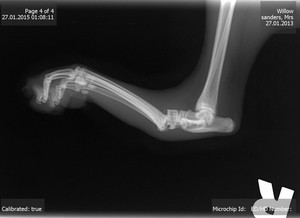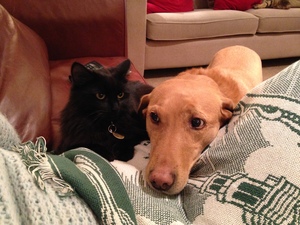Hollybank’s Brave pet of the Month…Willow!
Willow is lovely little black domestic long hair cat who presented to us one morning with sudden onset hind limb lameness; her owner reported she was non weight bearing to very minimally toe touching with her right hind leg.
When an animal presents with lameness we want to examine all aspects of that limb to localise the exact area of pain. We usually start at the top and work our way down. First we examine the hip joint (Coxo-Femoral joint), then progress downwards examining the long thigh bone (Femur), knee (Stifle joint), long bones (Tibia and Fibula), ankle joint (Tarsus), foot (Metatarsals) and lastly the digits (Phalanges).
Willow had considerable swelling located over her ankle joint although she was extremely tolerant and brave during her exam. She didn’t give much indication of pain other than some mild wriggling. Willow had no obvious wounds on her leg and we could not feel any obvious fractures. Her paw however, was stuck outwards at an abnormal angle and her nails were all scuffed.
There are many different potential diagnoses for a lame cat: wounds, cat bite abscesses, sprains and strains of musculoskeletal tissues, bone fractures, joint dislocations or luxation and osteoarthritis. However, due to Willows clinical signs (severe lameness, swelling, pain, abnormal foot position and scuffed nails to indicate some trauma) we were concerned that something more serious was on the top of our differential diagnosis list. As a result, we recommended x-rays.
Willow had to be sedated for her x-rays and whilst under sedation we were able to feel some instability of the ankle joint. The x-rays showed that Willow had a Tarso-Metatarsal joint luxation; this means that Willows foot (metatarsals) had shifted away from her ankle (tarsus) so that they no longer met to form a normal joint. Willow had been very determined to make it home with her injury and definitely deserves to be our brave pet of the month!
We sent the x-rays to an orthopaedic specialist who confirmed the luxation and advised us that Willow would need surgery. To repair the luxation Willow’s joint would have to be surgically fixated back into the correct position; this is done with a plate and screws fitted internally or with an external fixation apparatus. This type of surgery would also require a specialist surgeon and post-operatively Willow would need long periods of rest to give the joint the best chance of healing.
Although many orthopaedic fixations are very successful, as with any procedure we perform we cannot predict its success. When placing foreign material inside the body we also have to be aware for the potential of secondary complications where intensive management is sometimes needed. As Willow was not insured we had to take this all into account in our decision and decided that this was not a feasible option.
As Willow was otherwise a very fit and healthy cat with a lovely temperament we elected to perform complete hind limb amputation. The following day Willow had her right hind leg amputated and the operation went well. She stayed in with us that evening to receive pain relief and ensure she remained comfortable. Willow was already trying to move around the next day and was enjoying lots of fuss and cuddles so we were happy to send her home.
 Even within a couple of days Willow was moving around really well and determined to get back to exploring. At Willows post operative check she was doing remarkably well; her wound had healed nicely and she was quickly acclimatising to life on three legs.
Even within a couple of days Willow was moving around really well and determined to get back to exploring. At Willows post operative check she was doing remarkably well; her wound had healed nicely and she was quickly acclimatising to life on three legs.
Willows owners are delighted with how well she is doing and Willow is just as delighted to be back with her family, especially Fox Red Labrador, Bracken, who she truly believes is her mummy!




